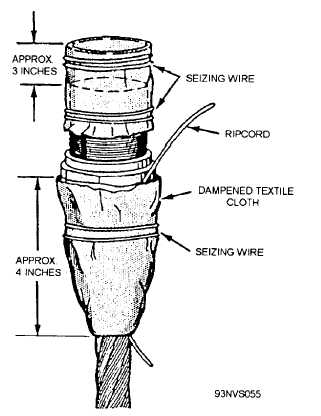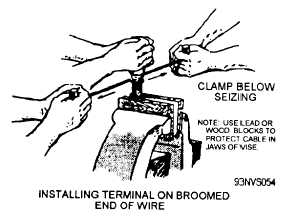NOTE
The zinc must be heated to a range of
950 to l,000°F for pouring.
The
temperature may not exceed 1,075°F.
Discard zinc that has been heated above
1,075°F.
Measure the
temperature
frequently with a portable pyrometer.
Preheat the ladle prior to immersing it in
the molten zinc.
Clamp the wire rope vertically, below the
seizing, in a vise having copper- or lead-protected
jaws. The wire rope should be clamped sufficiently
tight to hold the wire firmly but not so tight as to
deform the lay.
Attach wooden handles to each end of a length
of soft steel wire that has been cleaned in the same
way as the broomed-out cable and terminal. Loop
this wire once around the broomed-out wires. Pull
the wire to tighten the loop, and compress the
broomed-out wires together. See figure 3-54,
CAUTION
Do NOT touch broomed-out wires with
greasy rags or hands.
Start the terminal on the compressed wires and
slide it onto the wire rope until the bottom rests on
the seizing. See figure 3-54.
Reclamp the wire rope in the vise in a vertical
position at a point approximately 5 inches below the
seizing. Make sure the terminal is not tilted in any
way.
Figure 3-54.—Installing the terminal.
Degrease and secure two turns of copper wire
around the broomed-out wire rope, 1/2 inch beyond
the top of the screw-type terminal or 1/8 inch
beyond the grip area of a basket-type terminal.
Draw the broomed-out wires inward and away from
contact with the terminal so that there is
approximately 1/1 6-inch clearance between the wire
and the inner wall or the terminal.
Wet a roll of plaster of paris bandage in
lukewarm water and squeeze out the excess water.
Wrap the plaster of paris bandage around the base
of the terminal at a distance of about 4 inches.
Press the bandage firmly to the contour of the
terminal and wire rope. (See fig. 3-55.) Dampen a
textile cloth with water and wrap it around the
plaster of paris and secure it with seizing wire. The
textile cloth may extend far enough to protect the
wire rope from the torch while the terminal is being
heated.
the
on
Heat the terminal carefully and uniformly with
torch, making certain the flame is not directed
the exposed wire rope at the bottom of the
Figure 3-55.—Textile cloth applied to the terminal.
3-57





